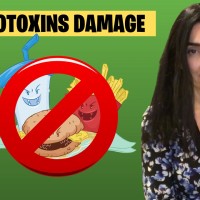
What’s FDA-approved and destroys your neurons? Excitotoxins!
Let’s explore excitotoxin, determine what they are in and if you are eating them. Knowledge is empowering to help you become your best health advocate and make the healthiest choices for your body, neurons and life.
Watch the video to learn more. Listen to the podcast to absorb all the empowering morsels.
Excitotoxins are amino acids: glutamic acid (glutamate) and aspartic acid (aspartate), commonly added to processed food. Excitotoxins are added to foods and beverages that literally stimulate neurons to death. They can cause brain damage of varying degrees and a host of health ailments. You can find them in foods or supplements that contain MSG (monosodium glutamate), glutamic acid, glutamine, NutraSweet, aspartate, aspartame, cysteine hydrolyzed protein, and aspartic acid. It’s interesting to note that mercury and aluminum can trigger glutamate release. This is why reading labels is vital to healthy living. If you do not know what the ingredient is then look it up or better yet, do not eat or drink it. Excessive levels of glutamate have been linked to a range of neurodegenerative diseases, including Alzheimer’s disease, ASD, Parkinson’s disease, Huntington’s chorea, stroke, Multiple sclerosis, and ALS. You can actually test your levels of excitotoxin in an organic acid test to detmeurine if it’s overwhelming your body. Mercury and aluminum can also serve to trigger glutamate release.
How do excitotoxins negatively impact neurons? For starters, glutamate is an excitatory neurotransmitter in the body essential for learning and memory. It’s the precursor to the inhibitory neurotransmitter, GABA which is the calming neurotransmitter, also essential for speech. if there’s an imbalance of excitatory and inhibitory neurotransmitters between glutamate and GABA then we see neurological inflammation. If we cannot regulate the glutamate then it can build up to toxic levels.
High levels of glutamate and aspartate are found naturally in protein rich foods, wheat gluten, and milk casein.
1. MSG (Monosodium Glutamate)
This salt form of glutamate, or glutamic acid, has been known to trigger headaches for decades. Glutamate easily crosses the blood-brain barrier, stimulating cell receptors that triggers cell death. Flooding the body with dietary glutamate can seriously disrupt normal cellular function, especially in the brain. Avoid foods with MSG, but remember there are other names for it so check labels for ingredients with the names:
Natural flavor(s)
Flavoring
Hydrolyzed vegetable protein
Autolyzed protein
Plant Protein
Textured Protein
Yeast extract
Nutritional yeast
Carrageenan
Anything with glutamate
2. Aspartate
Aspartate, or aspartic acid, acts like glutamate. This non-essential amino acid triggers NMDA receptors in cells, another of the cellular receptors used to initiate cell death. Most humans receive aspartate through consuming aspartame, an artificial sweetener often hidden in many processed foods. It has been linked with serious neurological effects such as headaches, sleep disorders, migraines, and seizures.
3. Domoic Acid
Another non-essential amino acid, domoic acid occurs naturally in shellfish. Excessive overconsumption has shown to lead to the development of epilepsy, especially in the elderly. If you’re a seafood eater, pick wild-caught varieties of fish like salmon.
4. L-BOAA
Also known as ODAP, this protein is another excitotoxin that behaves in similar fashion as glutamate. It naturally occurs in the grass pea and similar plant species, chickling pea from the plant Lathyrus sativus grown in drought prone areas.. Overexposure to grass pea and L-BOAA leads to neurolathyrism, a disorder that affects motor skills and movement.
5. Cysteine
Industrially created by hydrolysis of human hair and poultry feathers, this excitotoxin is important for artificial flavor creation and high levels are associated with Parkinson’s and Alzheimer’s disease. It reacts with sugars in a process known as the maillardreaction, resulting in meaty and savory flavors.
6. Casein
This milk protein compound occurs in cheese at naturally high levels. 20% of casein is glutamic acid which increases glutamate overload. Casein is often used by food producers to improve flavor and used to increase protein levels in ‘fitness’ products and whey protein.
7. Gluten
Glutamine peptides are often derived from wheat. Wheat gluten (over 40% free glutamate by weight).
Natural sources of free glutamate:
• Foods matured, cured, or preserved, such as matured cheeses (Parmesan and Roquefort) and cured meats
• Fish sauce
• Soy sauce and soy protein
• Mushrooms
• Ripe tomatoes
• Broccoli
• Peas
• Walnuts
• Grape juice
• Bone broths and meats cooked for long times (generally using moist cooking methods such as braising)
• Malted barley used in breads and beer
• Wheat gluten (over 40% free glutamate by weight)
• Dairy casein (about 25% free glutamate by weight)
According to the Farlex Partner Medical Dictionary © Farlex 2012: Excitotoxicity is the “Neuronal death resulting from increased intracellular glutamate; neuronal ischemia leads to ATP loss and depolarization, with glutamate release from synapses, and subsequent overstimulation leading to sodium and calcium ion gate porosity.”
What to do? Get tested to determine your levels, avoid foods containing excitotoxins, take natural supplements to boost GI health, natural detox, liver support and glutathione levels. Stay hydrated and keep a food journal to determine patterns between your overall wellness and your food and beverage intake.
Disclaimer: You should always speak with your physician before taking any medication or nutritional, herbal or homeopathic supplement, or adopting any treatment for a health problem. If you have or suspect that you have a medical problem, promptly contact your physician. Never disregard professional medical advice or delay in seeking professional advice. Information and statements regarding dietary supplements have not been evaluated by the Food and Drug Administration and are not intended to diagnose, treat, cure, or prevent any disease.
Don’t want to miss the monthly live presentations then became a member today.!
Take Charge of your health by joining Total Wellness Monthly Membership.
Tags: Excitotoxins, msg, NutraSweet, the taste that kills
Leave A Reply (No comments So Far)
No comments yet